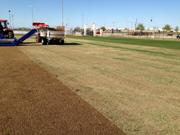
Features
Agronomy
‘Fraise’ mowing a viable alternative to field replacement
November 27, 2014 By Mike Jiggens
By Kevin White
Lead Athletic Field Specialist
Seattle University
With a growing event list and need for higher venue utilization, sports turf managers now face the ever-growing problem of increased turf “wear-and-tear” and the increased demands to have a year-round playable surface.
To combat this problem, some teams simply replace sod annually; however, fraise mowing is a popular and viable substitute for field replacement.


Background
In the early 1990s, Ko Rodenburg—a leading superintendent in Rotterdam, Holland—invented the Field Topmaker. His invention removed 100 per cent of thatch and organic buildup that accumulated each season. At the same time, the machine removed the poa annua plants and seed accumulation while leaving the crown grass for regeneration. This process would become known as “fraise mowing.”
Rodenburg then overseeded and fed the fields, allowing the grass to regenerate quickly as well as keeping them nearly thatch and organic-free. The entire process is referred to as “KORO Renovation.”
The Field Topmaker consists of five blades, which are adjusted from five centimetres above the surface to the same distance below. The cut material is deflected back onto the surface, or transferred by built-in conveyors directly into trailers for removal off site.
Verticutting and core aeration for thatch and organic management removes eight to 14 per cent on grass fields, whereas fraise mowing provides an option to remove up to 100 per cent. Fraise mowing was first introduced in the U.S. in 2013.
The benefit of this new process was immediately recognized, as Rodenburg's fields became stronger and more durable. The re-growth of the grass was hardier than the original crop. Additionally, the compaction potential of the surface was reduced because the organic buildup was cleaned out and the disease pressure was nearly eliminated with the removal of the thatch.
To date, fraise mowing has become the standard “across the pond.” Many of the elite sports pitches in Europe are renovated annually and considered some of the best in the world.
U.S. case study
Allen Reed, CSFM, sports turf manager for Major League Soccer’s FC Dallas and a long-time member of the Sports Turf Managers Association (STMA), was one of the first Americans to commit to fraise mowing.
During a weekend demonstration in March 2013 under Reed’s supervision, Toyota Stadium—the home of FC Dallas—had three natural grass fields receive the Koro renovation process. They were fraise mowed with the Universe fraise mower, leaving behind a mat of stolons and rhizomes that immediately re-generated leaf blades to begin growth laterally across the ground. The cork screw motion of the universe successfully “cleans out” the thatch and foreign material in the top layer of a bermudagrass field without removing the strong, established plants.
The process was a success and within 14 to 21 days, the field surface was nearly recovered with strong, durable plants ready to sustain heavy traffic. The process also smoothed undulations in the surface, creating a higher quality playing field than before. The fields were completely covered and ready to resume play in seven weeks in spite of the below normal temperatures.
Benefits of fraise mowing
Fraise mowing is still a relatively new process to the U.S. turfgrass industry. While thatch management techniques (such as core aeration, verticutting and spring tine raking) have been in place for years, fraise mowing brings a solution to thatch buildup. Additionally, it is far more cost-effective than new sod, and eliminates the problem of having to match your existing sand profile. While it is not as quick of a fix as sod replacement, the long-lasting durability of the natural grass creates a stronger, more stable field.
Networking and sharing best practices
In recent years, the sports turf industry has become more cohesive. The sharing of best practices, such as fraise mowing, is increasing among turfgrass leaders through organizations such as the STMA.
The 26th annual STMA Conference & Exhibition will be held Jan. 13-16, 2015 in Denver, Colo. Nearly 1,200 sports turf professionals will converge on the Colorado Convention Center for more than 75 hours of leading-edge educational seminars, exhibitor demonstrations and networking opportunities.
More than 60 educational sessions and panel discussions will feature sports turf managers along with academic and commercial representatives from schools, colleges and universities, parks and recreational facilities, and professional sports stadiums.
To learn more, visit http://www.stma.org/2015-conference .
Print this page